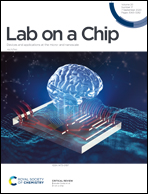Polymorphic calcium alginate microfibers assembled using a programmable microfluidic field for cell regulation†
Abstract
Effectively guiding and accurately controlling cell adhesion and growth on the surfaces of specific morphological materials are key issues and hot research topics for optimizing biomaterials. Herein, novel polymorphic alginate microfibers formed through microfluidic spinning technology in a single microchip are presented. Through programming the flow and reaction kinetics in microchannels, other than self-modified micromorphic channel geometry, polymorphic microfibers with precisely tuned curvature-adjustable morphology can be obtained. Finite element (FE) simulations of the flow field (unidirectional fluid–solid coupling) proved the efficacy of the proposed control strategy. Moreover, the specific disordered–ordered cell arrangements showed a linear relationship between bioinspired alginate microfibers with different curvatures and the orientation angle of L929 cells, and diversified growth morphologies, including oblate ellipse, star, tree and strip shapes, occurred on the customizable interface curvature of the calcium alginate microfibers, providing a paradigm for using specific structured natural biomedical materials for cell regulation. This work represents a new design concept for manufacturing polymorphic fibrous biomedical materials through a unique marriage of the fields of green chemistry, hydromechanics, and biomaterials, which should be very useful for guiding the controllable construction of alginate materials for use in structural materials for biomedical and engineering purposes.



 Please wait while we load your content...
Please wait while we load your content...